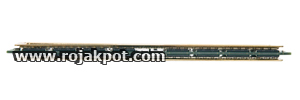The XTC Heatspreader
The XTC heatspreader is a new development by OCZ. Like Mushkin's new heatspreaders, these heatspreaders aim to improve the thermal dissipation of the module by increasing the air flow beneath the heatspreaders and around the memory chips.
But instead of following the Mushkin open top design, OCZ took a different route by using a unique honeycomb design. Take a look.
The honeycomb design supposedly increases air flow by means of micro-convection through the holes. This reduces the amount of dead space and heat build-up under the heatspreader. The holes also increase the surface area for thermal dissipation.
If you are using a fan to blow across these modules, the holes will also allow air to flow through, thereby increasing the heatspreader's thermal dissipation. However, if you take a close look under the heatspreader, you will see a continuous layer of thermal tape.
Here, you can see the thermal tape, through the holes in the honeycomb pattern.
With the thermal tape effectively blocking the holes, we wonder just how effective this honeycomb design is. There doesn't seem to be any place for air to circulate under the heatspreader. 
Incidentally, if you intend to actively cool these modules, the sticky nature of the thermal tape will likely lead to the dust sticking to them and clogging up the holes in the heatspreader. If you are a stickler for cleanliness, you should let these modules be cooled passively.
After all, the honeycomb design is supposed to help circulate air by micro-convection. This alone should improve the heatspreader's thermal dissipation without the need for active cooling.
<<< The Module, Module Specifications : Previous Page | Next Page : The Memory Chip, Memory Chip Specifications >>>







 Add to Reddit
Add to Reddit



